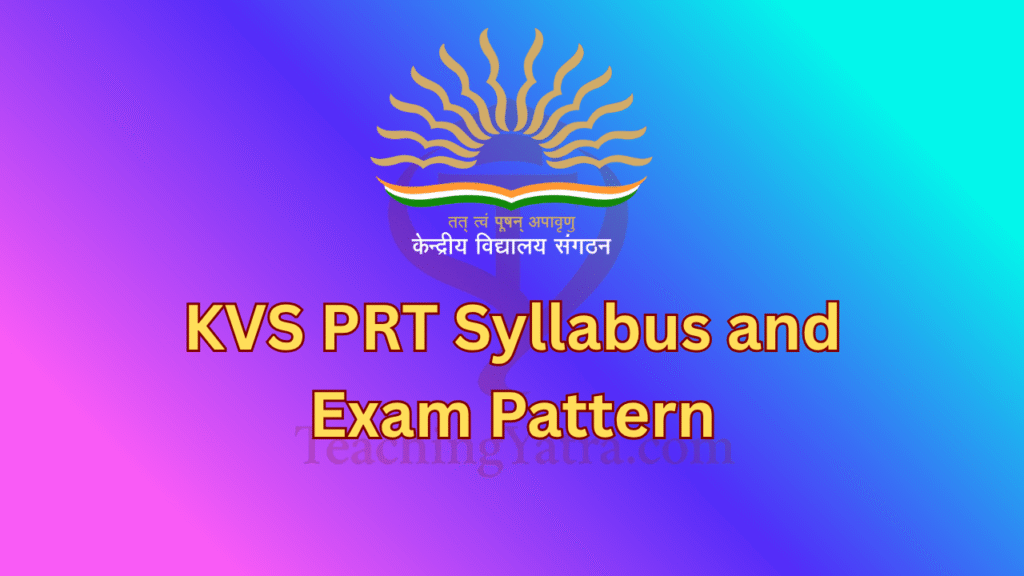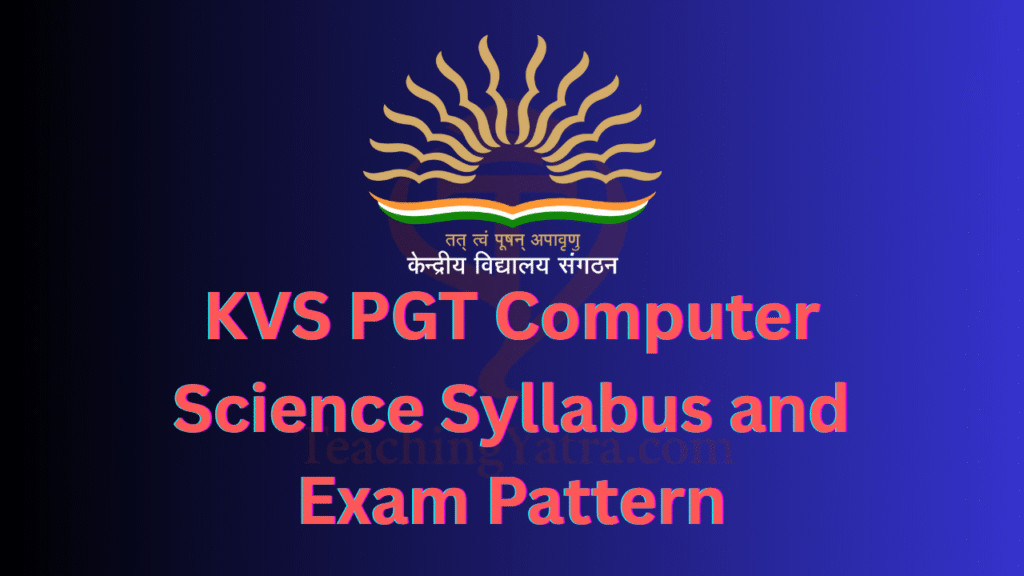
If you’re preparing for the KVS Primary Teacher (PRT) Exam 2025, understanding the latest syllabus and exam pattern is the first step toward success. Kendriya Vidyalaya Sangathan (KVS) conducts the PRT exam to recruit qualified teachers for primary classes (I to V) across India. The exam is conducted in online CBT mode and includes sections on language skills, general awareness, reasoning, computer literacy, pedagogy, and subject knowledge. This post provides a detailed breakdown of the KVS PRT exam structure, marking scheme, and topic-wise syllabus to help you plan your preparation effectively.
Table of Contents
KVS PRT Syllabus 2025: Overview
The KVS PRT Exam 2025 is conducted to recruit eligible candidates for the post of Primary Teacher (PRT) in Kendriya Vidyalayas across India. The exam is held in online mode and consists of multiple sections to test the candidate’s knowledge, teaching aptitude, and subject understanding relevant to primary education.
Key Highlights:
- Exam Name: KVS PRT (Primary Teacher)
- Conducting Body: Kendriya Vidyalaya Sangathan (KVS)
- Exam Mode: Computer-Based Test (CBT)
- Total Marks: 180
- Total Questions: 180 (1 mark each)
- Duration: 180 Minutes (3 Hours)
- Negative Marking: No
- Medium: Bilingual (Hindi & English except language sections)
- Type of Questions: Objective (MCQs)
- Level of Questions: Class I to V (NCERT-based)
This overview gives you a quick idea of the exam format. Scroll down for the detailed section-wise syllabus and marking scheme.
KVS PRT Exam Pattern 2025
The KVS PRT Exam 2025 consists of 180 multiple-choice questions carrying a total of 180 marks, to be completed in 3 hours. The exam is divided into four parts:
- Part I tests language proficiency in General English and General Hindi
- Part II includes General Awareness, Reasoning Ability, and Computer Literacy
- Part III covers Perspectives on Education and Leadership
- Part IV focuses on Teaching Methodology and subject knowledge related to primary level (Class I–V).
The exam is conducted in both English and Hindi, except for the language sections. The objective format is designed to assess a candidate’s teaching aptitude, content knowledge, and general intelligence.
KVS PRT Exam Pattern & Marks Distribution
| Part | Subject | No. of Questions | Marks |
|---|---|---|---|
| Part I | General English | 10 | 10 |
| General Hindi | 10 | 10 | |
| Part II | General Awareness & Current Affairs | 10 | 10 |
| Reasoning Ability | 5 | 5 | |
| Computer Literacy | 5 | 5 | |
| Part III | Perspectives on Education and Leadership | 60 | 60 |
| Part IV | Subject Concerned (e.g., Science, Maths) | 80 | 80 |
| Total | 180 | 180 |
Detailed KVS PRT Syllabus 2025
The KVS PRT syllabus is divided into four main sections: language proficiency, reasoning and general awareness, teaching-related knowledge (pedagogy), and subject-specific content. Here’s the section-wise breakdown:
Scheme & Syllabus of Exam for Direct Recruitment of PRTs
Part I – Proficiency in Languages (20 Marks)
(a) General English (10 Questions)
- Reading comprehension
- Word power
- Grammar & usage
(b) General Hindi (10 Questions)
- पठन कौशल
- शब्द सामर्थ्य
- व्याकरण एवं प्रयुक्ति
Part II – General Awareness, Reasoning & Proficiency in Computers (20 Marks)
(g) General Awareness & Current Affairs (10 Questions)
(h) Reasoning Ability (5 Questions)
(i) Computer Literacy (5 Questions)
Part III – Perspectives on Education and Leadership (60 Marks)
(a) Understanding the Learner
- Concept of growth, maturation and development, principles and debates of development, development tasks and challenges
- Domains of Development: Physical, Cognitive, Socio-emotional, Moral etc., deviations in development and their implications
- Understanding Adolescence: Needs, challenges and implications for designing institutional support
- Role of Primary and Secondary Socialization agencies, ensuring home-school continuity
(b) Understanding Teaching-Learning
- Theoretical perspectives on learning – Behaviorism, Cognitivism, and Constructivism with reference to:
i. Role of teacher
ii. Role of learner
iii. Teacher-student relationship
iv. Teaching methods
v. Classroom environment
vi. Discipline and power - Factors affecting learning and implications for:
i. Classroom instructions
ii. Student activities
iii. Creating learning spaces - Planning and Organization of Teaching-Learning:
i. Syllabus and Curriculum concepts, Overt and Hidden Curriculum
ii. Competency-based education, Experiential learning
iii. Year Plan, Unit Plan, Lesson Plan
iv. Instructional materials and resources
v. ICT for teaching-learning
vi. Evaluation: Purpose, types, limitations; CCE, good tool characteristics
vii. Assessment: of learning, for learning, as learning – meaning, purpose, and planning - Enhancing Teaching-Learning processes: Classroom observation, feedback, reflection, dialogues
(c) Creating Conducive Learning Environment
- Diversity, disability, and inclusion concepts; disability as a social construct
- Types of disabilities, identification, and interventions
- School mental health – curative, preventive, and promotive care
- Guidance and counselling
- Developing school and community as learning resources
(d) School Organization and Leadership
- Leader as a reflective practitioner, team builder, initiator, coach, and mentor
- Perspectives on school leadership – instructional, distributed, transformative
- Vision building, goal setting, School Development Plan
- Strengthening teaching-learning via school processes: annual calendar, time-table, PTM, school assemblies, teacher forums, achievement data, school self-assessment
- Community partnerships, industry links, networking with nearby schools and HEIs – building learning communities
(e) Perspectives in Education
- NEP-2020: Curriculum and Pedagogy – holistic and integrated learning, inclusive education, competency-based learning
- Child rights principles, safe school environment, RTE Act, 2009
- Historical view of National Education Policies
- School Curriculum Principles: Learning perspective, knowledge, curricular areas, school stages, pedagogy, and assessment
Part IV – Subject-specific Syllabus (80 marks)
Subject specific syllabus includes the concepts of NCERT/CBSE syllabus and Text Books (Classes I – V) as indicated under respective subject headings.
However, the questions will be testing the depth of understanding and application of these concepts at the level of Senior Secondary (upto class XII)
English:
Grammar: Nouns, pronouns, adjectives, adverbs, is, am, are, has, have, tense forms (Simple present and present continuous, simple past and past continuous), expressing future (will and be going to), articles, this, that, these, those (as determiners and empty subjects), question words, an, or, but, punctuation marks (full stop, comma, question mark and inverted commas), possessive adjectives, prepositions
हिन्दी:
व्याकरण: संज्ञा, विशेषण और वचन की पहचान और व्यावहारिक प्रयोग, गणित के पाठ्यक्रम के अनुरूप हिन्दी में संख्याएँ, संयुक्त अक्षरों की पहचान, पर्याय और विलोम (स्तरानुकूल), सर्वनाम और लिंग की पहचान, विशेषण का संज्ञा के साथ सुसंगत प्रयोग, वचन का प्रयोग, क्रिया, काल और कारक चिह्नों की पहचान, शब्दों के सन्दर्भ में लिंग का प्रयोग
Mathematics:
Geometry: Shapes & Spatial Understanding, Solids Around Us
Numbers: Developing a Sense of Numberness, Counting and Operations of Numbers, Addition and Subtraction, Multiplication, Division, Mental Arithmetic, Fractional Numbers
Money, Measurement, Length, Weight, Capacity (Volume), Time, Data Handling, Patterns
Environmental Science (EVS):
Family and Friends, Food, Shelter, Water, Travel, Things We Make and Do
Detailed KVS PRT Syllabus 2025 in Hindi
Part I – भाषाई प्रवीणता (20 अंक)
(a) General English (10 Questions)
- Reading comprehension
- Word power
- Grammar & usage
(b) सामान्य हिंदी (10 प्रश्न)
- पठन कौशल
- शब्द सामर्थ्य
- व्याकरण एवं प्रयुक्ति
Part II – सामान्य जागरूकता, तर्कशक्ति एवं कंप्यूटर में दक्षता (20 अंक)
(g) सामान्य जागरूकता एवं समसामयिक घटनाक्रम (10 प्रश्न)
(h) तर्कशक्ति क्षमता (5 प्रश्न)
(i) कंप्यूटर साक्षरता (5 प्रश्न)
Part III – शिक्षा और नेतृत्व पर दृष्टिकोण (60 अंक)
(a) शिक्षार्थी की समझ
- विकास, परिपक्वता और वृद्धि की अवधारणा, विकास के सिद्धांत एवं बहसें, विकासात्मक कार्य और चुनौतियाँ
- विकास के क्षेत्र: शारीरिक, संज्ञानात्मक, सामाजिक-भावनात्मक, नैतिक आदि; विकास में विचलन और उसके प्रभाव
- किशोरावस्था की समझ: आवश्यकताएँ, चुनौतियाँ, और संस्थागत सहायता के लिए सुझाव
- प्राथमिक और द्वितीयक सामाजिककरण एजेंसियों की भूमिका, विद्यालय और घर के बीच निरंतरता बनाए रखना
(b) शिक्षण-अधिगम की समझ
- अधिगम पर सैद्धांतिक दृष्टिकोण – व्यवहारवाद, संज्ञानात्मकता और निर्माणवाद, विशेष रूप से:
i. शिक्षक की भूमिका
ii. शिक्षार्थी की भूमिका
iii. शिक्षक-छात्र संबंध
iv. शिक्षण विधियाँ
v. कक्षा का वातावरण
vi. अनुशासन और शक्ति की समझ - अधिगम को प्रभावित करने वाले कारक और उनके प्रभाव:
i. कक्षा निर्देश की योजना
ii. छात्र गतिविधियाँ
iii. विद्यालय में अधिगम के लिए स्थान तैयार करना - शिक्षण-अधिगम की योजना और संगठन:
i. पाठ्यक्रम और पाठ्ययोजना की अवधारणा, प्रकट और अप्रकट पाठ्यक्रम
ii. दक्षता आधारित शिक्षा, अनुभवात्मक अधिगम
iii. वार्षिक योजना, इकाई योजना, पाठ योजना
iv. शिक्षण सामग्री और संसाधन
v. आईसीटी का उपयोग
vi. मूल्यांकन: उद्देश्य, प्रकार, सीमाएँ; सतत एवं समग्र मूल्यांकन, अच्छे उपकरण की विशेषताएँ
vii. अधिगम का मूल्यांकन: अधिगम के लिए, अधिगम के रूप में और अधिगम का मूल्यांकन - शिक्षण-अधिगम की गुणवत्ता में सुधार: कक्षा निरीक्षण, प्रतिक्रिया, चिंतन और संवाद
(c) अनुकूल अधिगम वातावरण का निर्माण
- विविधता, दिव्यांगता और समावेशन की अवधारणाएँ; दिव्यांगता को सामाजिक दृष्टिकोण से समझना
- दिव्यांगता के प्रकार, पहचान और हस्तक्षेप
- विद्यालय मानसिक स्वास्थ्य – उपचारात्मक, निवारक और संवर्धनात्मक देखभाल
- मार्गदर्शन और परामर्श की व्यवस्था
- विद्यालय और समुदाय को अधिगम संसाधन के रूप में विकसित करना
(d) विद्यालय संगठन और नेतृत्व
- नेतृत्वकर्ता के रूप में चिंतनशील अभ्यासी, टीम निर्माता, पहलकर्ता, कोच और मार्गदर्शक
- विद्यालय नेतृत्व के दृष्टिकोण – शैक्षणिक, वितरित और परिवर्तनकारी
- विज़न निर्माण, लक्ष्य निर्धारण और विद्यालय विकास योजना
- विद्यालय प्रक्रियाओं द्वारा शिक्षण को सशक्त बनाना: वार्षिक कैलेंडर, समय सारणी, अभिभावक-शिक्षक बैठकें, विद्यालय सभा, शिक्षक विकास मंच, उपलब्धि डेटा का विश्लेषण, विद्यालय आत्म मूल्यांकन
- समुदाय, उद्योग और आस-पास के स्कूलों व उच्च शिक्षा संस्थानों के साथ साझेदारी – अधिगम समुदाय बनाना
(e) शिक्षा में दृष्टिकोण
- नई शिक्षा नीति 2020: पाठ्यक्रम और शिक्षाशास्त्र – समग्र और एकीकृत अधिगम, समावेशी शिक्षा, दक्षता आधारित अधिगम
- बाल अधिकारों के मार्गदर्शक सिद्धांत, सुरक्षित विद्यालय वातावरण की व्यवस्था, नि:शुल्क एवं अनिवार्य शिक्षा अधिकार अधिनियम 2009
- राष्ट्रीय शिक्षा नीतियों का ऐतिहासिक दृष्टिकोण
- विद्यालय पाठ्यक्रम सिद्धांत: अधिगम दृष्टिकोण, ज्ञान, पाठ्यक्रम क्षेत्र, विद्यालय स्तर, शिक्षाशास्त्र और मूल्यांकन
Part IV – विषय-विशेष पाठ्यक्रम (80 अंक)
English:
Grammar: Nouns, pronouns, adjectives, adverbs, is, am, are, has, have, tense forms (Simple present and present continuous, simple past and past continuous), expressing future (will and be going to), articles, this, that, these, those (as determiners and empty subjects), question words, an, or, but, punctuation marks (full stop, comma, question mark and inverted commas), possessive adjectives, prepositions
हिन्दी:
व्याकरण: संज्ञा, विशेषण और वचन की पहचान और व्यावहारिक प्रयोग, गणित के पाठ्यक्रम के अनुरूप हिन्दी में संख्याएँ, संयुक्त अक्षरों की पहचान, पर्याय और विलोम (स्तरानुकूल), सर्वनाम और लिंग की पहचान, विशेषण का संज्ञा के साथ सुसंगत प्रयोग, वचन का प्रयोग, क्रिया, काल और कारक चिह्नों की पहचान, शब्दों के सन्दर्भ में लिंग का प्रयोग
गणित:
ज्यामिति: आकृतियाँ और स्थानिक समझ, हमारे चारों ओर ठोस वस्तुएं
संख्या: संख्याओं की समझ विकसित करना, गिनती और संख्याओं पर क्रियाएं, जोड़ और घटाव, गुणा, भाग, मानसिक गणना, भिन्न संख्याएं
पैसा, मापन, लंबाई, वजन, क्षमता (आयतन), समय, आंकड़ों का विश्लेषण, पैटर्न्स
पर्यावरण अध्ययन (EVS):
परिवार और मित्र, भोजन, आश्रय, पानी, यात्रा, जो चीज़ें हम बनाते और करते हैं
KVS PRT Syllabus PDF
The KVS PRT Syllabus PDF download link is provided below for easy access. It includes the complete syllabus for Primary Teacher, covering key subjects such as English, Hindi, Mathematics, and Environmental Studies (EVS) along with important teaching methodology and pedagogy topics. This subject-wise syllabus helps candidates understand the important topics and exam structure clearly.
Candidates are advised to download and save the syllabus PDF for effective planning and well-organized preparation.
KVS PRT Syllabus PDF Download Link

